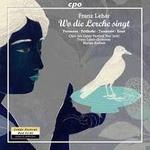|
Back
09/25/2014
Franz Lehár: Wo die Lerche singt
Gerhard Ernst (Török Pál), Sieglinde Feldhofer (Margit), Jevgenij Tauntsov (Sándor Zapolja), Wolfgang Gerold (Baron Árpád Ferenczy), Miriam Portmann (Vilma Garamy), Florian Resetarits (Bodroghy Pista), Sinja Maschke (Borcsa), Chor des Lehár Festivals Bad Ischl, Franz Lehár-Orchester, Marius Burkert (Conductor)
Recording: Festspielsaal Bad Ischl, Austria (August 14-16, 2013) – 129’52
cpo #777 816-2 – Booklet in German and English

   
Franz Lehár, best known for The Merry Widow (Die lustige Witwe) in 1905, went on to become a grand maser in the genre of operetta. Perched inside the muniments is a lesser known gem, Where the Lark Sings (Wo die Lerche singt), that stakes claim as Lehár’s second most successful work within confines of the Theater an der Wien. Similar to Witwe, Wo die Lerche singt retains a MGM appliqué and hummable melodies, chock full of spoken dialogue. Forming a friendship with Giacomo Puccini in the midst of The Great War, the inevitable bond can be credited through Alfred Maria Willner and Heinz Reichert, librettists who wrote two ornithological storylines, meted out for each composer: Puccini’s La rondine (1917) and Lehár’s Wo die Lerche singt (1918).
The aforementioned authors’ writing is rather weak, equating Wo die Lerche singt into a flashing of disjointedness. The operetta could be better characterized as a string of “sketches” with a yarn of absurdity in lieu of a plot with titanic grounding: country bumpkin versus a citified social climbing artistic painter…the two worlds meet, then fall apart. Everyone is happy in the end with countryside and city both satisfied. The unrealistic imagery still gives Lehár an excuse to create mellifluous arias, duets and ensembles. Resting deep within the bucolic Salzkammergut region is a worthy cast, crowned by Marius Burkert’s even and respectful musical tempo. The sound and volume are crisp and clear.
Synonymous with the “Lark” is our country girl, Margit, performed by Sieglinde Feldhofer. Lehár uses a novel approach for her introduction (“Entréelied”) by having her initialize the coloratura piece offstage and continuing onstage. With such a youthful look, it is surprising to hear the strength inside her soprano voice. Notes are precise and uncompromised, but there lacks an enveloped softness: a steely edge surrounds her higher notes. Early into the extended “Finale” of the “Erstes Bild”, we hear subtle shades of Ullmann and Zemlinsky. The piece shines under Burkert’s direction, carrying with it nicely formed crescendos to re-emphasize a romantic élan while Feldhofer closes the first quarter by polishing off a closing extended note.
Jevgenij Tauntsov’s Sándor has a ring of confidence and assuredness though the sound frequently comes across with overstated melodrama. Lehár consistently uses “reminisces” as a variegated leitmotif, the Vilma/Sándor combination being one of the most lovely, dreamy visions within the score. Miriam Portmann’s range is broad, volumetric and anchored in seasoned approach. Destined to be together from the get-go, their duet will instantly take one back to Witwe’s “Wie einen Rosenknospe” (Valencienne/Camille.)
Even an ounce of paternal happiness wends its way into the music that features Gerhard Ernst as Margit’s grandfather, Pál. The role has meager amounts of singing, a Germanic parallel to Maurice Chevalier, especially when we hear Ernst sing his lilting ditty “Das Lied von Temesvár” that adds a zip of flounce.
The “Entr’akt” leading into the “Drittes Bild” anticipates the Viennese upper class which quickly unveils gentile sophistication and eventual effusive glitter in the “Galopp” portion. The chorus is well-heeled in this brčve seléction. But Lehár never gains a permanent hold to this Austrian music, for his notes bring with it Hungarian zest and pizzazz in his Marches and Palotás.
Anyone delighting in infectiously entertaining melodies will surely want to grab hold of this cpo recording. It is frustrating to see not enough detail spent on expansion of the synopsis, for the writing does not reference what tracks correspond with what is written in prose. To the English reader, there is a lot of time spent on piecing everything together. Full libretto would help, but this absence is certainly understandable. Having basic tools to facilitate the enjoyment of such a wonderful operetta, however, is another story.
Christie Grimstad
|